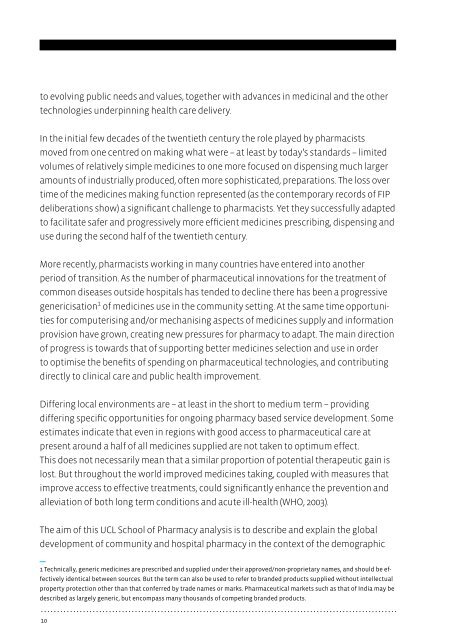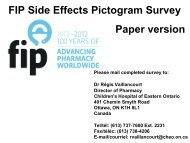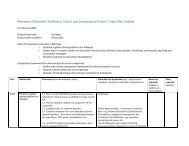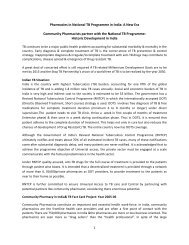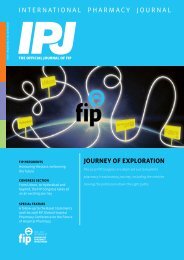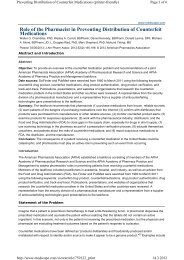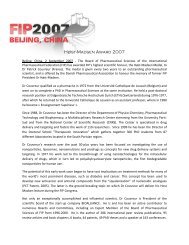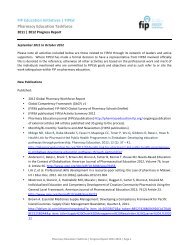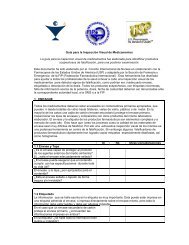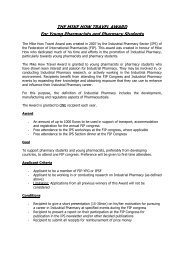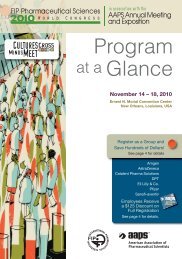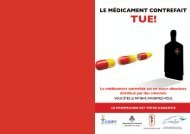Contents - FIP
Contents - FIP
Contents - FIP
Create successful ePaper yourself
Turn your PDF publications into a flip-book with our unique Google optimized e-Paper software.
to evolving public needs and values, together with advances in medicinal and the other<br />
technologies underpinning health care delivery.<br />
In the initial few decades of the twentieth century the role played by pharmacists<br />
moved from one centred on making what were – at least by today’s standards – limited<br />
volumes of relatively simple medicines to one more focused on dispensing much larger<br />
amounts of industrially produced, often more sophisticated, preparations. The loss over<br />
time of the medicines making function represented (as the contemporary records of <strong>FIP</strong><br />
deliberations show) a significant challenge to pharmacists. Yet they successfully adapted<br />
to facilitate safer and progressively more efficient medicines prescribing, dispensing and<br />
use during the second half of the twentieth century.<br />
More recently, pharmacists working in many countries have entered into another<br />
period of transition. As the number of pharmaceutical innovations for the treatment of<br />
common diseases outside hospitals has tended to decline there has been a progressive<br />
genericisation 1 of medicines use in the community setting. At the same time opportunities<br />
for computerising and/or mechanising aspects of medicines supply and information<br />
provision have grown, creating new pressures for pharmacy to adapt. The main direction<br />
of progress is towards that of supporting better medicines selection and use in order<br />
to optimise the benefits of spending on pharmaceutical technologies, and contributing<br />
directly to clinical care and public health improvement.<br />
Differing local environments are – at least in the short to medium term – providing<br />
differing specific opportunities for ongoing pharmacy based service development. Some<br />
estimates indicate that even in regions with good access to pharmaceutical care at<br />
present around a half of all medicines supplied are not taken to optimum effect.<br />
This does not necessarily mean that a similar proportion of potential therapeutic gain is<br />
lost. But throughout the world improved medicines taking, coupled with measures that<br />
improve access to effective treatments, could significantly enhance the prevention and<br />
alleviation of both long term conditions and acute ill-health (WHO, 2003).<br />
The aim of this UCL School of Pharmacy analysis is to describe and explain the global<br />
development of community and hospital pharmacy in the context of the demographic<br />
1 Technically, generic medicines are prescribed and supplied under their approved/non-proprietary names, and should be effectively<br />
identical between sources. But the term can also be used to refer to branded products supplied without intellectual<br />
property protection other than that conferred by trade names or marks. Pharmaceutical markets such as that of India may be<br />
described as largely generic, but encompass many thousands of competing branded products.<br />
10


